

Practical Recipes in Turkish Cuisine M. mr Akkor

New York Copyright 2014 Blue Dome Press 17 16 15 14 / 1 2 3 4 All rights reserved. No part of this book may be reproduced or transmitted in any form or by any means, electronic or mechanical, including photocopying, recording or by any information storage and retrieval system without permission in writing from the Publisher. Published by Blue Dome Press
244 5th Avenue, Suite D-149
New York, NY 10001, USA www.bluedomepress.com Art Director
Engin ifti Photographs
Semih Ural Epub
Ahmet Kahramanoglu DIJITAL ISBN: 978-1-935295-62-4 Printed by
alayan A.., Izmir - Turkey Preface

Changing the World and Traditional Cuisines French philosopher Jean Baudrillard discusses in his book, The Transparency of Evil , concepts such as aesthetics, politics, the economy, and art. He explains that these different concepts intermingle; they are no longer independent like in the past. For example, todays art is a trans-art that has political, economic, and aesthetic components.
Similarly, I believe that this intermingling is true of food and culture. Foods on our dining table are not authentic enough anymore. Recipes are now altered as a result of globalization, the economy, and cultural convergence. Fast food chains and globalization has had a dramatic impact on food culture. Because of globalization, people are curious about the cuisine of different cultures in different geographies. This curiosity has led to the opening of various international restaurants and the sharing of different ingredients.
Thanks to this, authentic cuisines are protected to some degree and the recipes which may have been forgotten are recorded. The intellectual progress and establishment of social awareness on this issue is one of my biggest wishes. Every passing day we encounter products with extended shelf-lives and nonperishable benefits. Some examples are sugars which can merge into the blood faster, foods that are supposed to make you full but actually make you more hungry, and fake products marketed as real foods such as sweeteners, thickeners etc. In fact, the science of molecular gastronomy has emerged as a reflection of this commercial development. Now chefs are cooking in laboratories instead of in their kitchens and are developing foods which are manipulated structurally.
People have already learned that the consumption of these structurally degenerated foods can cause many diseases. In response, the demand for organic products and non-processed foods has increased, just not enough. Another food related issue revolves around garnishing. The major difference between Western and Eastern cuisine is the emphasis placed upon the appearance of food. In our culture, food primarily has an ethical meaning. As a matter of fact, we have numerous idioms such as: dads furnace, sharing the bread, bringing salt to the table, sitting around the same dining table, and feeding the hungry.
Food in Islamic culture is a blessing; moreover, bread is sacred. Even stale bread would not be thrown into the trash but used in cooking. In our culture, meaning comes first and later comes the taste. Frivolity is not allowed around the dinner table as the blessing of food is respected and the meal is eaten with gratitude. For this reason, the way the food is displayed is not of huge significance to our culture. The spectacular feasts prepared by Franois Vatel, a very famous example from the traditional Western cuisine, seem to prove the difference between our cuisines.
In the Western culture, food decoration is substantial in meal preparation. The dining table is a place to chat, to watch shows, and to have fun. As I have written in the preface of my book, Bursa Cuisine , food travels from one location to another the same way people do. During these journeys, wherever it reaches it gets enriched via the influence of life conditions in those specific geographies. Turkish cuisine was enriched by interacting with other cultures in the Western and Islamic regions from the time of their arrival in Anatolia till today. I think the interaction of cuisines is more than just imitation.
While the effects of the interaction are positive, the effects of imitation are negative. As an executive chef, I am watching, with sorrow and anxiety, the degradation of our original recipes and cuisine by mixing the title of meals, the cooking styles, and the ingredients from very different cuisines with traditional ones. However, I also would like to mention that by all means I am not against the creativity, the quest for taste, and the use of different ingredients. Needless to say, experimental studies and the different presentation of plates should be practiced in the kitchen. Nevertheless, everybody is responsible for protecting their own cuisine and culture from assimilation. Turkish Culinary Culture Throughout the centuries, Turks were traditionally horsemen and nomads.
One of the fundamental effects of this lifestyle can be found in Turkish food culture. The Turks traveled with their horses and hair tents, adapting to the various climates, circumstances, and conditions. Sometimes they brought their culture to the new location and other times they collated their culture with what they took. This fast-paced life and rapid change developed and diversified their cultural structure. The Turks had taken a distinct stance and implemented the formation of a very comprehensive culture which had an impact on the whole world. In the beginning, Turkish food culture distinguished itself as being easy to prepare and storable.
Later on, it was altered according to the geographical conditions of the region they traveled to. However, the Turks absolutely never forgot where they came from and the culture they had brought. Wherever they stopped, they encountered new ingredients. These new ingredients were incorporated into their kitchen and led to fantastic recipes. Sometimes they altered a recipe by replacing an ingredient which they could not find with a new one; as a result, they created their own recipes wherever they were located. When they departed from Middle Asia and reached the Balkans, they were no longer the Turks that they were at the beginning of their journey.
Turkish people endured massive difficulties and challenges during this journey, which lasted many miles and many years. In the end, the remainder of these obstacles was the Turkish culture with its great heritage. Perhaps it is not possible to know exactly what they used to eat when they first stepped out of Middle Asia on their horses; however, what Turkish people eat today is quite obvious. Speaking of Turkish Cuisine... Turkish cuisine is not only found within the borders of Turkey. When we say Turkish cuisine, we should think not only of the cuisine of Turkish people who live in Turkey, but also the cuisine of all people with a Turkish identity.
We may extend the same example for Anatolia. At the present time, even though we describe it as the cuisine of people who live in Anatolia, Anatolian cuisine consists of the cuisine of various civilizations, such as the Hittites, Seljuks, and Romans. Anatolias geography, vegetation, and other conditions have remained the same for thousands of years. That is why it is possible to come across the same dessert from the time of the Hittites in orum or Bursa. Food is a large component of any culture, and it is up to us to protect it under any circumstance. At the same time, we must continue to expand and differentiate ourselves.


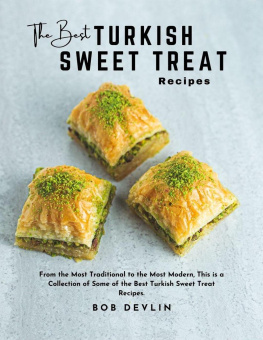
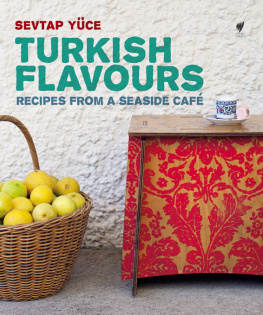
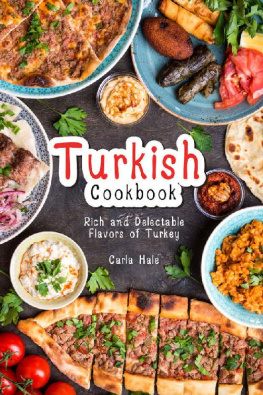
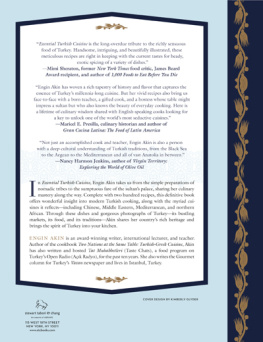
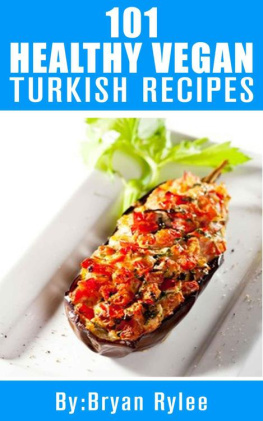
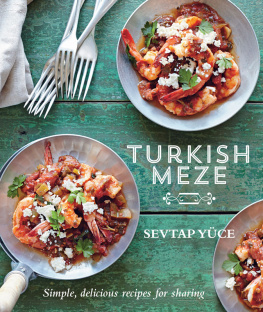
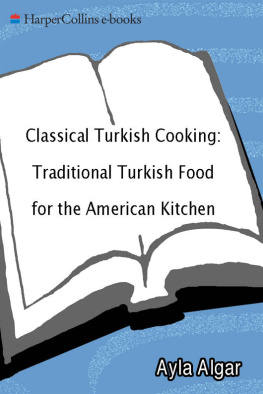
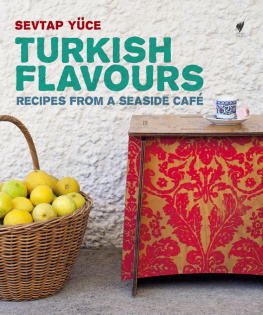
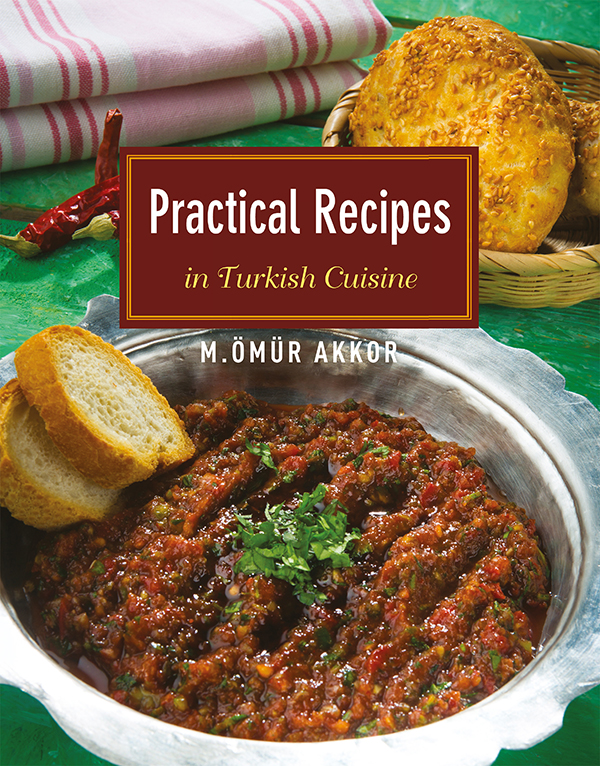

 Practical Recipes in Turkish Cuisine M. mr Akkor
Practical Recipes in Turkish Cuisine M. mr Akkor 
 Changing the World and Traditional Cuisines French philosopher Jean Baudrillard discusses in his book, The Transparency of Evil , concepts such as aesthetics, politics, the economy, and art. He explains that these different concepts intermingle; they are no longer independent like in the past. For example, todays art is a trans-art that has political, economic, and aesthetic components.
Changing the World and Traditional Cuisines French philosopher Jean Baudrillard discusses in his book, The Transparency of Evil , concepts such as aesthetics, politics, the economy, and art. He explains that these different concepts intermingle; they are no longer independent like in the past. For example, todays art is a trans-art that has political, economic, and aesthetic components.